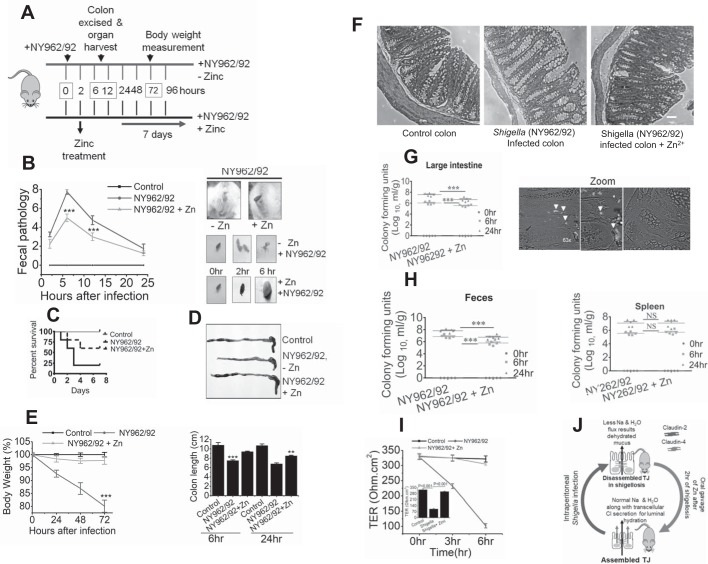Fig. 7.
Zn2+ protects Shigella-mediated pathogenesis in adult mice. A: timeline of experimental procedure of shigellosis in adult mice. B: fecal pathology of uninfected (Control) and Shigella-infected in presence (NY962/29 +Zn) or absence (NY962/92) of Zn2+. Scores were determined at 2, 6, 12, and 24 h (left). Fecal pathology (left) was determined using the basis of stool color and stool consistency (right). C: Kaplan-Meier survival curve comparing survival of individuals by Shigella infection with or without Zn2+ administration. D, top: representative colon images at 24 h postinfection in uninfected (Control) or 24-h post-Shigella-infected in presence (NY962/92 + Zn) or absence (NY962/92 – Zn) of Zn2+. Bottom: bar graph summarizes colon lengths of uninfected (Control) and 6-h and 24-h post-Shigella infection. E: body weight changes were monitored at different postinfection time points. Data are means ± SE of 3 independent experiments; n = 6 mice per group. ***P < 0.001 vs. Control and in Shigella-infected colon + Zn2+ administration, **P < 0.01 vs. Shigella-infected colon. F: representative Hematoxylin-eosin staining of mouse colon. Scale bars in all images, 100 µm. G: effect of Zn2+ supplementation on bacterial colonization in mice subjected to intraperitoneal infection with S. flexneri 2a. Colony-forming units (CFU) in homogenates of large intestines. Phase images of postinfected tissue showing significant burden of green fluorescent protein (GFP)-positive NY962/92 along the villi at 3 h. time point, stained with anti-GFP (middle) and uninfected control (left). White arrows mark bacterial colonies. Zoomed image depicts magnified view of bacterial colonization; n = 3 mice per group. H: CFU in homogenates of feces and spleen (right) at each time point postinfection with NY962/92. Data represent mean of 3 independent experiments; n = 5 mice per each group. ***P < 0.001 vs. Shigella infection without Zn2+ administration at 6 and 24 h. P values were calculated using the Mann-Whitney U-test. I: transepithelial electrical resistance (TER) in mouse colon were measured in Ussing chambers. Data are means ± SE of 6 animals in each group. Inset: TER quantification derived from time course study. J: graphic demonstration of critical roles of claudin-2 and -4 in Shigella infection. Shigella infection alters intestinal permeability and mucosal dehydration by regulating tight junction (TJ) protein claudin-2 and -4 internalization into cytoplasm. Zn2+ supplementation helps reestablish altered intestinal permeability in shigellosis by reinstating claudin-2 and -4 on TJ membrane, resulting in decreased mouse mortality.

